They say… 
Best beer and travel writing award 2015, 2011 -- British Guild of Beer Writers Awards
Accredited Beer Sommelier
Writer of "Probably the best book about beer in London" - Londonist
"A necessity if you're a beer geek travelling to London town" - Beer Advocate
"A joy to read" - Roger Protz
"Very authoritative" - Tim Webb.
"One of the top beer writers in the UK" - Mark Dredge.
"A beer guru" - Popbitch.

|
London beer tastings 2011
ABV: 4.2%, 6.8% and 5.3%
Origin: Leyton, London E10, England
Website: brodiesbeers.co.uk
 Brodie's Amarilla English Summer Ale Brother and sister James and Lizzie Brodie exercise two of the most fertile imaginations in London brewing in their small brewhouse behind the sprawling old William IV near Leyton Green. When I spoke to James earlier in the year, they’d brewed 40 different beers since taking over and reviving the derelict brewery in 2008, and I wouldn’t be surprised if the total is now 60 and rising.
The beers have ranged from traditional British styles and historical recreations to all manner of delightful eccentricities. There’s been an East End rye beer made in the presence of a rabbi, a 22% naturally fermented Elizabethan Ale, a strong chilli-infused dark lager named Doppel Dunkel Weiße Heiße, and a Pink Pride beer brewed in solidarity with victims of homophobic violence. There are beers with American hops, spiced and fruit beers, imperial stouts, and various pleasing nods to the cosmopolitan culture of East London with, for example, real ale versions of Caribbean stouts.
The pair’s father Brian Brodie has owned the pub for 13 years, and back in 2000 he worked with a third party to set up the Sweet William brewery, fitting out the stables with a new five barrel (8hl) plant designed and installed by Rob Jones of Dark Star. But things didn’t quite work out and brewing ceased in 2005, until three years later when James and Lizzie, longtime homebrewers, revived it, becoming one of the first of a new wave of London brewers.
When I visited the William to gather some tasting samples for a BEER piece about London bottle conditioned beers to tie in with the launch of my London guidebook, I ended up picking up 12 bottles out of a huge range, and with these and numerous other opportunities, I now have notes on approaching 30 Brodie’s beers. In this and subsequent postings I’ve picked out nine of the most interesting.
 Brodie's Californian Amarilla is one of the most popular beers, described as an English summer ale but with definite American pale influences, and foregrounding the character of the Amarillo hop, as pronounced in East London. A cask version I tasted at the William was a slightly hazy light gold with hardly any head and a grapefruit and passion fruit aroma with a slightly sweated hop note. A nice light grainy palate had more exotic fruit with lychee and grapefruit, taking on a more syrupy note in the mouth. A long, decent and refreshing slightly thistly finish turned bitterish with perhaps a slight slick of fatty dark chocolate. The combination of grainy middle and vivid fruity hop notes accounts for the beer’s appeal.
Black IPA, or Cascadian Ale as it’s sometimes known, is currently high fashion in the world of internationl beer geekery, a hybrid style combining American IPA-like hopping with dark porter-style malts. I’ve not been entirely convinced by some of the examples I’ve tried as they seemed too much of a shouting match of strident roast and citric hops. But Brodie’s Black IPA, which I sampled on cask during the William’s late summer festival, is one of the more successful.
The beer is black with a bubbly yellowy beige head and a spicy dark resiny aroma balanced by malt. There’s thick toffee and dark cake on a sweetish palate followed almost immediately by a firm through controlled pinne and citrus hit, with enough fruity complexity to foffset the bitterness. A fruity, smooth, dark and chewy finish remains thick and citric with lingering marmalade flavours.
Californian was one of my review bottles, a pale yellow very lively beer with a thick white head that makes a virtue of the piney Chinook hop. This is obvious in a resiny hop aroma with some vegetal farmyard and light pinoli notes. A crisp vanilla malt palate is immediately beset by chewy, piney, grapefruit hop flavours which remain fresh and assertive but not overbitter. The chewy resinous finish has hints of light malt, earthy lime and peach.
For more Brodie’s beers see next post.
Read more about these beers at ratebeer.com: http://www.ratebeer.com/brewers/brodies/3911/
National Homebrew Competition, Bristol 2011
 National Homebrew Competition 2011: the view from the judging sheet. Pic: Phil Lowry of beermerchants.com. Home brewing still struggles with a bad reputation in the UK. Folk memories of Boots kits bought principally on the promise of only a few pence for a pint “just like you drink down the pub” but instead producing smelly, cloudy concoctions that remain the only alcoholic drinks left unfinished at the end of the party — such stereotypes die hard. When I told friends and colleagues I was going to judge a homebrew competition, their commiserations were delivered without a hint of irony.
This is unfair. There are many other fields of human endeavour where able and enthusiastic amateurs (and let’s not forget that for all its negative connotations the word derives from the Old French for ‘lover of something’) are accepted as capable of producing work that rivals and occasionally even exceeds in quality that of professionals — think of cookery or gardening, for example.
These same occupations enjoy healthy communication and interchange between amateur and professional spheres. In the USA and some other countries where a flourishing craft brewing scene has been built from scratch on the tabula rasa of a beer culture effaced by industrial brewing, the vast majority of commercial brewers have been recruited from among home brewers, and the ties remain close — witness the various ‘pro-am’ events and competitions on the other side of the Atlantic, and the commercial beers that began as prizewinning homebrew competition entries.
In Britain, where a tradition of commercial craft brewing persisted, the first generation of microbrewers was largely made up of professionals fleeing or made redundant from bigger breweries. Brewing on a domestic scale was once the norm, of course, but the ascendancy of the “common brewer” established a received wisdom that the “mysteries of the craft” were way beyond the scope of unpaid dabblers equipped with tea urns and plastic buckets, an assumption reinforced by most people’s experience with those 1970s Boots kits.
This assumption is becoming increasingly untenable. If doubts remain, they would quickly have been dispelled by random tastings of the entries at the UK National Homebrew Competition held in Bristol at the beginning of September 2011, where the quality the best homebrewers are capable of was obvious for all to taste. It was also significant that, besides homebrewing experts, the judging panel included some of Britain’s leading professional brewers — people of the calibre of Fuller’s John Keeling and Moor’s Justin Hawke — as well as beer writers and other industry figures, all of whom felt privileged to be asked, though it was purely on a voluntary basis and at their own travelling expense. Bristol Beer Factory, one of the UK’s more forward looking micros, offered invaluable practical assistance.
The crowd of hopeful entrants, helpful stewards and curious judges that gathered at the Tobacco Factory — the regenerated former Imperial Tobacco works in a now-trendy part of south Bristol — reflected the changing complexion of Britain’s developing beer scene. The home brewers were predominantly youthful and clearly alive to international beer culture — though almost exclusively male. Far from being an easy way of making pints for a pittance, brewing is for many of them a consuming pastime that involves serious commitment in terms of equipment and time.
This wasn’t about kits and malt extracts — pretty much all the beers in the competition were “full mash”, brewed from scratch with malt and hops just as in the commercial sector. In fact four entries were from professional brewers who made them at home, permissible under the rules of the competition which admitted any beer brewed on non-commercial equipment. The fact that full time brewers also spend their free time brewing is a demonstration of quite how much passion drives the industry.
I’ve judged at numerous commercial beer competitions but this was quite a different experience, and not just because we were asked to use the BJCP guidelines, of which more below. The bane of commercial competitions is not bad beer but boring beer — beer created under the pressure of marketing departments so obsessed with giving it the widest possible appeal they end up creating the lowest common denominator. Tasting a succession of technically flawless but bland beers with nothing distinctive to say for themselves can be a dispiriting experience.
Home brewers have no such commercial imperative — they brew to please themselves, and to satisfy their own curiosity. Yes, there were a scattering of misfires, “gushers” and bad beers in Bristol, perhaps a few more than you’d expect from the commercial sector (who are by no means immune to technical problems), but blandness certainly wasn’t an issue. The relatively high numbers of entries in the American pale, IPA and Belgian ale categories illustrates the point. The imagination on display was reflected in the final Best in Show winners — a delicious porter flavoured with vanilla, an American amber and a Bavarian-style wheat beer bursting with authentic spicy and fruity flavours.
Organiser and home brewer Ali Kocho-Williams says that, though there have been previous national competitions run by British home brewers’ club the Craft Brewing Association, this was almost certainly the biggest event of its kind yet organised in the UK, with 243 entries and 116 participants. And it was the first to use the BJCP guidelines. This is yet another example of how US craft beer culture, which was originally partly inspired by the beer consumer movement in Britain, is now returning the compliment by feeding the aspiration and imagination of young British brewers and beer connoisseurs.
The Beer Judge Certification Program was first set up in the 1980s by the American Homebrewers Association (AHA) and, although it is now adminstered by its own organisation, its accreditations and procedures remain in use for AHA competitions. The first BJCP exam in the UK was held in January this year and a number of official Beer Judge badges were proudly on display in Bristol.
“I got involved in the BJCP and qualified as a judge via the New York City Homebrewers Guild,” Ali told me. “I got excited and enthused, and came back to Bristol with a head full of ideas about developing a homebrew club. About a year ago I floated the idea within what was then a nascent Bristol Brewing Circle of organising a competition. This was originally going to be a regional event, but open to all. When the Craft Brewing Association announced that they weren’t going to run their competition this year, I was urged to turn ours into a national event. It all rather went from there.
“We decided to adopt the BJCP because it offered a much broader set of guidelines than those previously used in the UK. It also gave the beers a much better chance of being fairly assessed and for brewers to receive detailed feedback. Following the first British BJCP exam, there were qualified judges around, and judges need to be active in order to maintain their status. What I didn’t expect was that it would make me the point of focus for competitions in the UK, nor that I would have over 50 people asking me to organize BJCP courses and exams here so that they could qualify as judges!”
At first I felt a little apprehensive about the BJCP angle. I’m not a certified judge — I’ve had no formal beer tasting training — and I was flattered that my knowledge and experience was thought sufficient to exempt me from qualification. American culture takes these things very seriously, applying a thoroughness and rigour which to British eyes can seem a little, well, anally retentive. And in common with other US beer competitions like the World Beer Cup, the BJCP gives great weight to the principle of judging to style guidelines: currently the program recognises around 80 beer styles grouped into 23 major categories, each one defined by a detailed description of at least 500 words.
Perfectly good beers can be marked down if they fail to conform to these. A fellow judge – who was BJCP accredited – and I actually had an example of this during the competition, where a rather decent beer in one of our flights had clearly been entered in the wrong category by someone who hadn’t read the guidance properly. With some heavy heartedness we duly marked it down, though perhaps not as ruthlessly as we ought to have done.
While I appreciate that judging beers within style categories helps to establish a level playing field so like can be judged against like, I’ve long been uncomfortable with the straitjacket such a system might place on the creativity of brewers if too rigorously enforced. On the other hand, the categories cover a very broad range of possibilities so brewers should be able to find a place for even their most eccentric creations, in the catch-all ‘specialty beer’ category if nowhere else.
In the event I got used to speed reading the style guidelines, which helpfully include commercial examples considered to be within the specified style, and quickly got the hang of the detailed scoring. Although more complex than any other judging system I’ve yet used, I had to agree it helped give fair consideration to each beer.
Ali’s experience suggests home brewing’s place within the UK’s wider beer culture is at something of a turning point. “There are more home brewers, and more of them are moving away from beer kits and experimenting with new ingredients – quality products that weren’t available before, like imported hops from the US, New Zealand and Australia,” he says. “And although the crossover between professional and home brewing is not as developed as in the US, it’s growing.”
He’s certainly right on that last point. Britain has a mushrooming crop of microbreweries, and increasingly the people behind them come from outside the established industry. Some plunge straight into commercial brewing, often with the aid of an experienced business partner or consultant. But many come through home brewing, either by taking up brewing purely as a hobby and only later deciding to turn it into a business, or by using home brewing deliberately as a springboard to a commercial operation.
One of Britain’s highest achieving new brewers, Evin O’Riordan of the Kernel in London, is a good example of that last group. He returned from a stay in the US determined to become a working craft brewer, and honed his skills through home brewing, becoming involved with the Durden Park Beer Circle, a group of amateurs who dedicate themselves to recreating historic British recipes. Evin is a key figure in the London Brewers Alliance, the umbrella group for the capital’s multiplying craft breweries, where London Amateur Brewers is also represented. And recently one of Britain’s most outstanding micros, Thornbridge, has teamed up with pub chain Nicholson’s in an arrangement familiar in the USA, running a home brewing competition in which the prize is the chance to produce the winning beer commercially.
All these developments are to be welcomed. As I said above, home brewers brew what they like, and the influence of the home brewing aesthetic is one of the main reasons why US craft brewing today is so eclectic, dynamic and innovative. British brewing could make good use of the energy, creativity and love of the amateur, ensuring that the gap between the beer kit and the commercial micro is filled to everyone’s benefit.
Read a full list of winners at www.bristolhomebrewcompetition.org.uk. For more about the BJCP see www.bjcp.org.
There’s a blog piece about the event and more pics by Phil Lowry here: http://beermerchants.wordpress.com/2011/09/03/national-homebrew-competition-2011/
First published in Beers of the World June 2009
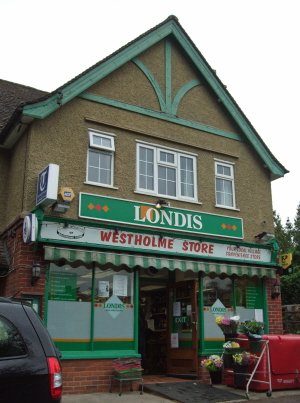 Westholme Stores, Goring-on-Thames -- not your average local Londis. Beer writing is full of unexpected pleasures – such as finding oneself in a pretty English village interviewing the owner of one of the best-stocked beer retailers in the region over a plate of homemade Gujarati dhokra and spiced puris. My host is the genial Jayesh Patel, better known locally as Jack, and as we chat, the surprises just keep on coming.
For a start, Westholme Store, or simply Jack’s, a large converted suburban house in a residential street in Goring-on-Thames, looks on the surface like an ordinary convenience store, and indeed functions as such. Part of the Londis franchise, it does a good trade supplying the locals with everyday necessities and is also, in the best traditions of such places, something of a community meeting point.
 Shelves at Westholme Stores, Goring-on-Thames But examine the aisles nearest the checkout and you’ll find a dazzling range of rare and classic bottled beers. When fully stocked, there are around 650 on offer. Two thirds are British, mainly from small producers. Jayesh is proud to offer beers from local Thames Valley and Cotswold brewers such as Ridgeway, Appleford and West Berkshire but there’s plenty from all over – he deals with distributors and takes advantage of Londis’ own direct delivery arrangements, but also sources hard to find beers by personally persuading breweries to cooperate locally in supplying mixed pallets. Scotland (BrewDog, Williams Brothers) and Yorkshire (Hambleton, Kelham Island) are currently particularly well represented.
Then there are the Belgians – Trappists, abbey beers and strong specialities with tiny outfits like Alvinne, Angerik and Serafijn alongside bigger names – plus some good German lager, Kölsch and Weissbier, a couple of Czechs, US stalwarts Anchor, Brooklyn and Flying Dog and a range of world lagers that digs rather deeper than Chang and Keo. There’s a handful of real ciders too, though currently no glasses nor other beer-related items.
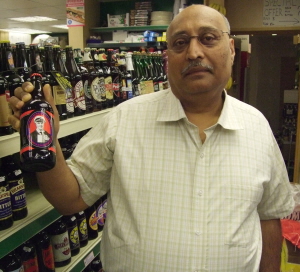 Jayesh Patel of Westholme Stores, Goring-on-Thames And the next big surprise is – Jayesh is passionately interested in beer but doesn’t drink. “When I lived in Kenya I used to drink Tusker but I gave up alcohol a long time ago,” he explains, “though I do sip to taste if we’re opening bottles.” A couple of years back, having run the shop since 1988, he felt he’d exhausted the potential of the local market and was searching for ways to attract customers from further afield.
 Serious gourmet beers at Westholme Stores He tried wine but found himself struggling against supermarkets. Then he stumbled on an article on a CAMRA website asking why more corner shops didn’t stock good beer. The spark was ignited and he threw himself into research, visiting other retailers, studying books, magazines and websites and taking courses.
The strategy has worked – he’s now a destination shop for beer enthusiasts in the region. But, perhaps more importantly, he’s also winning new converts. Locals popping in for a pint of milk or a lottery ticket are fascinated by the array of unusual bottles and labels, and more than a few have been tempted to experiment, under Jayesh’s expert guidance.
 Well, they say that Rochefort can sometimes develop a banana note. He’s also taken advantage of being in an Area of Outstanding Natural Beauty, where the river Thames slices through the Chilterns to form the Goring Gap. Three popular walking trails – the Thames Path, the Ridgeway and the Chiltern Way – pass close to the shop, and there are cycle routes and good rail connections, so you can spend a day enjoying the area and go home with a few bottles of something unusual. Then there’s the traffic on the river itself – in the summer he walks the towpath handing out flyers to boaters.
Among future plans are tasting evenings in the village hall with brewers and beer writers, extended trips around the UK to source more obscure delights, and a mail order service. What he’s already achieved inevitably leads you back to pondering the original question that inadvertently started it all – why don’t more corner shops stock good beer?
Fact file
Address: 24-26 Wallingford Road, Goring-on-Thames RG8 0BG
Phone: +44 (0)1491 872619
Web: www.beersnale.co.uk
Hours: 0600-1930 (Sun 1300)
Drink in? No
Mail order: Planned
Manager’s favourites: Kenya Tusker, Ridgeway IPA, Krönleins Crocodile
Beer picks
- Appleford Power Station 4.2%, Appleford, Oxfordshire. Tasty, complex bottle conditioned bitter with biscuity, slight burnt rubber notes, pippy peppery hops and spiced orange.
- Hambleton Nightmare 5%, Melmerby, North Yorkshire. Excellent flavour-packed burgundy-brown stout from renowned microbrewer: blackcurrant pastilles, burnt toast, raisiny fruit and soft chocolate.
- Ridgeway/Hepworth Oxfordshire Blue 5%, Sussex / Oxfordshire. A fine golden summer ale with a flowery fruit salad aroma, fruity floral palate and a lemon jelly and peach finish.
- Thornbridge Jaipur 5.9%, Ashford, Derbyshire. Authentic IPA at an approachable strength, with dried apricots, spiced orange and nettly hop resins in a puckering pepper finish.
- West Berkshire Dr Hexter’s Healer 5%, Yattendon, Berkshire. Toast, autumn fruit, citrus peel and rounded rooty bitterness in a chunky amber ale brewed for and named after a Wantage landlord.
This was the last of my Beer Sellers pieces published in Beers of the World as the July 2009 issue turned out to be the last. All have now been archived on this site, where new instalments continue to appear occasionally.
Beer sellers: Westholme Store
ABV: 4.2%
Origin: Wallingford, Oxfordshire, England
Website: www.applefordbrewery.co.uk
 Appleford Brewery Co Based on a farm in rural Oxfordshire at Brightwell-cum-Sotwell near Wallingford, Appleford was founded in 2006 by Andrew Torrance, formerly an accountant at the Morland brewery which was bought and closed by Greene King. Beers tend to be sold locally.
The bottle conditioned version of the brewery’s standard bitter Power Station, named for the nearby landmark power station at Didcot, is amber with a fine beige head and a fruity, lightly sulphurous aroma with a spicy orange whiff. The palate is full and biscuity with notes of toast, yeast, wet plastic and burnt rubber. A hoppy bitter finish has a tinge of tart apple core and gritty roast notes. Substantial and tasty, though best drunk fresh.
Read more about this beer at ratebeer.com: http://www.ratebeer.com/beer/appleford-power-station/62396/
Beer sellers: Westholme Store
ABV: 5%
Origin: Melmerby, North Yorkshire, England
Website: www.hambletonales.co.uk
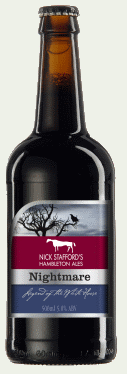 Hambleton Nightmare Stout Nick Stafford’s Hambleton brewery is one of the most technically accomplished of British micros — and its founder is one of the more prominent characters on the beer scene. As commercial director of small brewers’ organisation SIBA, among other achievements he established the Direct Delivery Scheme enabling small brewers to sell to pubs owned by pub companies without the beer being trucked through central depots.
The brewery, which makes much of its Yorkshire identity and its roots in the community, has expanded and moved twice since being founded in 1991 — since 2005 it’s been on an industrial estate in picturesque Swaledale. The logo is a representation of the Kilburn White Horse, a local landmark cut into a hillside not far from the brewery in the 1850s, and many of the beer names have equine themes.
The bottled beers don’t get round as much as they ought to, which is a shame, as bottling capacity is one of the brewery’s strengths — they also contract bottle for around 30 other breweries and are proud of their quality record. They make no apologies for not bottle conditioning, instead cold filtering their beers, and the results demonstrate that if bottled with care, filtered beer can rival “real ale in a bottle” at its best.
Nightmare is a great example. This “stout porter” was one of the brewery’s early award winners in cask, and the bottled version lives up to that reputation. I’d place it as a particularly smooth and lighter coloured example of a stout, but the standard beer judging guidelines published by the BJCP in the USA cite it as an example of a “brown porter”. It’s made from four malts — I suspect brown and chocolate malt amongst them.
The beer is dark brown with a burgundy tinge and a fine beige head. A burnt toast, caramel and blackcurrant pastille aroma forms a prelude to a smooth and complex palate with lots of fruit — physalis, raisins, plums — and notes of toffee and liquorice, offset by a pleasant chocolate dryness and a touch of acidity. A slight sweetness mellows a chewy, burry hop fnish with more fruit that finally turns gently pursing.
The name is one of the brewery’s horsey puns but the beer is the stuff much more pleasant dreams are made on.
Read more about this beer at ratebeer.com: http://www.ratebeer.com/beer/hambleton-nightmare-bottle/5545/
Beer sellers: Westholme Store
ABV: 5%
Origin: Horsham, West Sussex, England
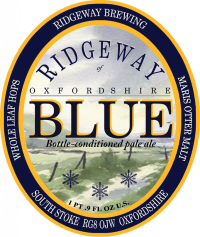 Hepworth Ridgeway Oxfordshire Blue Ridgeway, based at South Stoke just south of Wallingford in Oxfordshire, is a beer firm set up by former Brakspear brewer Peter Scholey when that historic company pulled out of brewing. The brand name references the prehistoric trackway, the Ridgeway, which passes nearby on its way along the crest of the chalk Chiltern Hills. The beers, however, are brewed some way south though still in chalky country, in Horsham, Sussex, at Hepworth — set up by Andy Hepworth, another survivor of an independent brewery closure, in this case King & Barnes.
Strong bitter Oxfordshire Blue claims to be “the first bottle conditioned beer brewed deliberately to taste great chilled with food at a barbecue” but it’s decent enough on its own. A hazy golden peachy colour with a thick white head, it has a flowery fruity salad aroma with a curious leather strap undertow. The palate is also floral and fruit salad tinged, at first dry and spicy though with a sugary note and flowery resinous hops. A lemon jelly finish has sweetish malt, peach fruit and crisp twiggy hops that turn peppery bitter later.
Read more about this beer at ratebeer.com: http://www.ratebeer.com/beer/ridgeway-oxfordshire-blue/59530/
Beer sellers: Westholme Store
ABV: 5%
Origin: Yattendon, West Berkshire, England
Website: www.wbbrew.com
 West Berkshire Dr Hexter's Healer From the image on the label, you might guess that Dr Hexter was some eccentric Victorian quack, but he turns out to be a more contemporary local character — the landlord of a pub in Wantage for whom this beer was originally developed. The brewery, too, began in a pub — the Potkiln in Filsham, where it was founded in 1995 by Dave and Helen Maggs. In 1997 it relocated to a freestanding plant which has since expanded into what the owners are proud to describe as the biggest independent brewer in Berkshire.
Brewed from Maris Otter barley and with three hop varieties including a US import, this decent strong bitter, sampled in filtered, bottled form, pours mid-amber with a decent off-white head. The malty, toasty aroma has fruit and olive notes and polleny hops. A smooth and malty palate has autumn fruit, citrus feel and a developing grapefruit hop tang offset by a sugary note. The long, rounded and bitterish finish has sappy fruit and malt and a slight mineral tang.
It may not do much to heal you, but it could certainly perk you up a bit.
Read more about this beer at ratebeer.com: http://www.ratebeer.com/beer/west-berkshire-dr-hexters-healer/1310/
 The Lade Inn and Scottish Real Ale Shop, Kilmahog, Callander, Scotland A couple of decades ago, a Scottish Real Ale Shop would have sounded like a preposterous joke. Though Scotland boasted notable historic brewing centres such as Alloa and Edinburgh, in the post-war period Scottish brewers moved further and faster with consolidation and the development of pasteurised national keg brands than their colleagues south of the border. On the formation of CAMRA in 1971, only two significant Scottish independent cask beer brewers were still in operation, and the country was regarded as a real ale desert for some time thereafter.
 Vintage Belhaven clips at the Scottish Real Ale Shop The change, when it came, was dramatic. A mushrooming of micros has pushed the country’s craft brewery count to around 50. Consumer demand has been fed by a growing domestic interest in fine Scottish food and drink, one strand of a growing cultural distinctiveness boosted by devolution in 1999. And some breweries have done very well by playing to Scotland’s romantic international cachet and the Scottish diaspora in the tourist and export markets.
Against this background, the opening of the Scottish Real Ale Shop at Kilmahog, in the Trossachs near Callander, in 2007 was a particularly smart move. There’s not a little irony in the fact that this shop window of Scotland’s beer renaissance is on the site of a former temperance tea room. The handsome whitewashed building sits on the A821 just beyond its junction with the A84 between Stirling and Loch Earn, where the road crosses a lovely burn, the Garbh Uisge (“rough water” in Gaelic). It was built in 1935 as the Wayside Tea Rooms and Guest House for two teetotal sisters who ran it until 1965, after which – to their horror – it became licensed and known as the Lade Inn.
When Frank Park took over the pub in 2005, a recently installed microbrewery in an outhouse was producing beers developed with Douglas Ross of the nearby Bridge of Allan brewery, now Traditional Scottish Ales. But the brewery proved a headache and Frank closed it shortly afterwards, contracting the beers to TSA. Considering a new use for the outhouse, he and his son-in-law Fred Wilde settled on the idea of a beer shop. Fred has since gone on to repeat the trick for another region with a burgeoning beer scene, opening the award winning West Country Ales in Cheddar, Somerset.
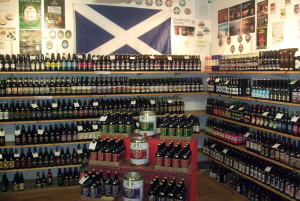 Interior of Scottish Real Ale Shop Over 130 beers from over 30 different breweries are stocked in the relatively small but pleasantly appointed space. Besides good ranges from relatively well distributed producers like Arran, Belhaven, Broughton and Williams Brothers, there are generous showings from Fyne and Traditional Scottish Ales, and bottles from a small breweries in far-flung parts of the country: Cairngorm in Aviemore, Colonsay in the Western Isles, Isle of Skye, An Teallach in Wester Ross. Lovers of strong special beers will be delighted by Traquair House and Jacobite ales, Harviestoun’s Ola Dubh, Innis & Gunn special issues such as the lovely Canada Day, and Orkney Dark Island Reserve.
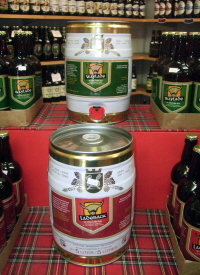 The Lade Inn's own brands, brewed by Traditional Scottish Ales nearby. If truth be told the shop’s name is something of a misnomer as only a minority of the beers satisfy the definition of Real Ale in a Bottle: bottle conditioned beers are still rare in Scotland and most of the beers on sale here are filtered. Exceptions come from Black Isle, Islay, Tryst and the tiny Moulin brewery near Pitlochry. The Lade Inn beers are on sale of course, including in minikegs, and there are a few ciders, glasses and T-shirts. Tastings are provided most weekends and the Trossachs Beer Festival, held across the pub and shop in late August and early September, recently celebrated its fifth year.
 Giant wall sign at Scottish Real Ale Shop, in case passing tourists are in any doubt. It’s a stunning setting in which to explore fine ales. Across the bridge the conifers of the Queen Elizabeth Forest Park clothe the lower slopes of Ben Ledi (879m), while further along the road the spectacular lochside of Loch Venacher reaches into the heart of the Trossachs. Back to town along the A84, red kites hover over the Callander Crags that tower forbiddingly above this handsome Victorian resort. In 2002 the area’s natural beauty was recognised when it became part of Scotland’s first national park, Loch Lomond and the Trossachs.
Yet it’s surprisingly accessible. Callander is one of the park’s gateway towns with a reasonable bus service from Stirling: I got here this way on my first visit, completing my journey with an easy 20 minute walk on the walking and cycling route that follows a disused railway alongside the burn. My next visit was in a car with an empty boot – it’s only about an hour’s drive from Glasgow and not much longer from Edinburgh.
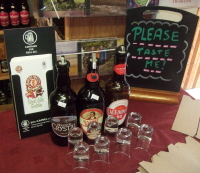 A wee tasting never went amiss. The setting lures customers from across the Central Belt and beyond. “We have regulars from Washington DC who have a summer cottage here,” says Frank, “and we’ve sent beer to most European countries, Japan and Australia, mainly to people who know the beers from visiting Scotland.
“The variety of Scottish ales is tremendous,” he continues. “And over the past few years we’ve seen great improvements in quality and consistency: we have very few customer issues with our stock. I believe we’ll see more and more small breweries springing up over the next few years, particularly those targeting the local customer with local ales.” The real ale desert seems a distant memory.
Fact file
Address: Lade Inn, Kilmahog, Callander FK17 8DN
Phone: +44 (0)1877 330152
Web: www.theladeinn.com/microbrewery
Hours: 1200-1800 (1230-1830 Sundays) or by special arrangement at other times within licensing hours
Drink in? Selected lines also sold in neighbouring pub
Mail order: via website
Manager’s favourites: Lade Inn LadeBack (the bestselling beer in both shop and pub) and a wide range of other beers.
Beer picks
All from Scotland
Beer sellers: Scottish Real Ale Shop; Top Tastings 2011
ABV: 4%
Origin: Larbert, Falkirk, Scotland
Website www.trystbrewery.co.uk
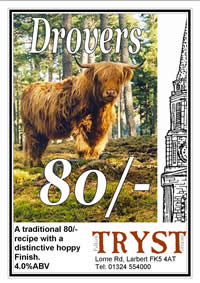 Tryst Drovers 80/- Tryst is a strong candidate for the list of the most underrated breweries in the UK — I don’t think I’ve ever had a bad beer from this micro just outside Falkirk. The wide range of accomplished bottle conditioned beers is particularly rare and noteworthy among Scottish brewers. A good number of the beers are unusual and innovative for Scotland, but brewer John McGarva can also turn his hand to traditional styles, as with this impressive take on an 80/-.
The beer is a rich mid-brown with a creamy beige head and a slightly yeasty and varnishy aroma yielding spice cake, malt and figgy fruit tones. The toasty malt palate has a lightly fruity note with sweetish cinder toffee flavours and a suggestion of sage in a dab of herbal hops, the result of a modest but noticeable late addition to the kettle. A gentle hop burr emerges from a comforting, lightly roasty sweetish malt finish with the slight crack of burnt toast.
There’s some more background to the brewery in my review of Brockville Dark and Carronade IPA.
Read more about this beer at ratebeer.com: http://www.ratebeer.com/beer/tryst-drovers-80–aka-wheel-ale/71979/
Beer sellers: Scottish Real Ale Shop
ABV: 4.5%
Origin: Throsk, Stirling, Scotland
Website: www.traditionalscottishales.com, www.theladeinn.com
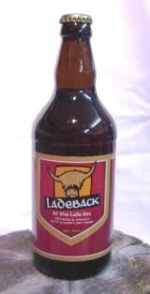 Traditional Scottish Ales Lade Inn LadeBack In 2003, the owners of the delightful Lade Inn in the Trossachs near Callander decided to add to the pub’s attractions by opening a microbrewery in an outbuilding, developing a range of own brand beers in collaboration with Douglas Ross of Bridge of Allan Brewery. In the event the brewery proved problematic and shut down a year later, the building later being converted into specialist off license the Scottish Real Ale Shop, but the beers endured, brewed under contract by Douglas at what’s now Traditional Scottish Ales. They’re available in cask in the pub, but also in filtered, bottled form as an additional point of interest in the shop.
LadeBack is business owner Frank Park’s particular favourite, a well balanced and accessible amber Scottish ale which I enjoyed on cask at the pub. A biscuity, slightly whiskyish and orange tinged aroma rises from a smooth and persistent yellowy-white head. The palate is malty and smooth with sweet fruit and controlled rooty hop notes. The finish is subtly fruity and creamy with a touch of powdery dryness in a careful balance of malt and hops. You can almost forgive it the groan-inducing name.
Read more about this beer at ratebeer.com: http://www.ratebeer.com/beer/trossachs-ladeback/34499/
|
Cask  This pioneering new book explains what makes cask beer so special, and explores its past, present and future. Order now from CAMRA Books. Read more here. This pioneering new book explains what makes cask beer so special, and explores its past, present and future. Order now from CAMRA Books. Read more here.
London’s Best Beer  The fully updated 3rd edition of my essential award-winning guide to London’s vibrant beer scene is available now from CAMRA Books. Read more here. The fully updated 3rd edition of my essential award-winning guide to London’s vibrant beer scene is available now from CAMRA Books. Read more here.
|
























